 W
WThe akakia was a cylindrical purple silk roll containing dust, held by the Byzantine emperors during ceremonies, and symbolizing the mortal nature of all men. It possibly developed from the mappa, the cloth used by the Roman consuls to start the races at the hippodrome.
 W
WThe Battle of Amioun was a battle which took place in Amioun El-Koura, in 694 between Byzantine troops and Monothelite Christians. The battle of Amioun devotes the independence of the first Maronite state, with Baskinta as capital.
 W
WThe Baptistery of St. John the Baptist of Thessaloniki, considered as the oldest early Christian baptistery and assigned to the building complex of a five-aisled episcopal basilica of the fifth century.
 W
WThe Battle of Pharsalus was fought in late 1277 at the plain of Pharsalus in Thessaly between an invading Byzantine army led by the megas stratopedarches John Synadenos and megas konostaulos Michael Kaballarios, and the forces of John I Doukas, ruler of Thessaly. This was the first major Byzantine campaign against Thessaly after the failure of the previous expedition at the Battle of Neopatras. The battle resulted in a crushing victory for John Doukas: Synadenos was captured, while Kaballarios died shortly afterwards of his wounds.
 W
WThe Battle of the Blarathon, also known as the Battle of Ganzak, was fought in 591 near Ganzak between a combined Byzantine–Persian force and a Persian army led by the usurper Bahram Chobin.
 W
WBrontochion Monastery is a monastery in Mystras, Greece.
 W
WThe term Byzantine commonwealth was coined by 20th-century historians to refer to the area where Byzantine general influence was spread during the Middle Ages by the Byzantine Empire and its missionaries. This area covers approximately the modern-day countries of Greece, Cyprus, North Macedonia, Bulgaria, Serbia, Montenegro, Romania, Moldova, Ukraine, Belarus, southwestern Russia, and Georgia.
 W
WThe city of Byzantium in the Byzantine Empire occupies an important place in the history of garden design between eras and cultures. The city, later renamed Constantinople, was capital of the Eastern Roman Empire and survived for a thousand years after the fall of the Western Roman Empire. The gardens of Byzantium were, however, mostly destroyed after the 15th-century Turkish conquest of the city.
 W
WByzantium: The Early Centuries (1989) is a popular history book written by English historian John Julius Norwich, published by Viking.
 W
WThe Cambridge History of the Byzantine Empire c.500-1492 is a history of the Byzantine Empire published by Cambridge University Press in 2009. It was edited by Jonathan Shepard of the University of Cambridge.
 W
WThe Chatalar Inscription is a medieval Greek inscribed text upon a column in the village of Chatalar by the Bulgarian Kanasubigi Omurtag (815-831). It was unearthed in 1899 by the archaeologists Fyodor Uspensky, M. Popruzhenko, Vasil Zlatarski and Karel Škorpil.
 W
WChrist Bearing the Cross, is the icon painted by Nikolaos Tzafouris, a Greek Renaissance painter.
 W
WThe Church of Saint Catherine is a late Byzantine church in the northwestern corner of the Ano Poli, Thessaloniki, Greece. The church dates to the Palaiologan period, but its exact dating and original dedication are unknown. From its interior decoration, which survives in fragments and is dated to ca. 1315, it has been suggested that it was the katholikon of the Monastery of the Almighty. It was converted to a mosque by Yakup Pasha in the reign of the Ottoman sultan Bayezid II and named after him Yakup Pasha Mosque. In 1988, it was included among the Paleochristian and Byzantine monuments of Thessaloniki on the list of World Heritage Sites by UNESCO.
 W
WThe Forum of Constantine was built at the foundation of Constantinople immediately outside the old city walls of Byzantium. It marked the centre of the new city, and was a central point along the Mese, the main ceremonial road through the city. It was circular and had two monumental gates to the east and west. The Column of Constantine, which still stands upright and is known today in Turkish as Çemberlitaş, was erected in the centre of the square.
 W
WCount Belisarius is a historical novel by Robert Graves, first published in 1938, recounting the life of the Byzantine general Belisarius.
 W
WThe Covered Hippodrome was a covered courtyard that served as an antechamber to the Great Palace of Constantinople in Istanbul, Turkey. The French scholar Rodolphe Guilland also equated it with the emperors' private hippodrome. It lay on the southeastern corner of the palace complex, and connected the Palace of Daphne in the north with the later lower palace complex around Bucoleon in the south, through the gate of Skyla. It played a great role in imperial ceremonies, and is not to be confused with the far larger adjacent Hippodrome of Constantinople, which in Byzantine sources was often distinguished as the "uncovered" (ἀσκέπαστος) Hippodrome. From the 9th to the 11th centuries, it was also the site of one of the Byzantine capital's highest courts, the tribunals of the "judges of the Hippodrome" and of the "judges of the velum".
 W
WThe Dumbarton Oaks Papers journal (DOP) was founded in 1941 for the publication of articles relating to Byzantine society and culture from the 4th to 15th century in the Roman Empire and its neighboring states. The journal treats sources in medieval Greek, as well as other premodern languages, such as Arabic, Armenian, Coptic, Ethiopic, Georgian, Latin, Old Church Slavonic, and Syriac.
 W
WThe Fatih Mosque is a mosque in Tirilye, Bursa Province, Turkey, which was converted from an 8th-century Byzantine church dedicated to Saint Theodore. The building was constructed between 720 and 730 AD, originally as the Church of Christ and Saint Stephen. After the Ottoman conquest of the town, it was converted to a mosque and named "Fatih", which means "conquest". The mosque was briefly rededicated as a church during the Greek occupation of the area in the Greco-Turkish War of 1919–1922.
 W
WThe Hagia Sophia at Nicaea is a Byzantine-era church in Nicaea in Turkey.
 W
WThe Hestia Tapestry is a Byzantine-era pagan tapestry made in the Diocese of Egypt in the first half of the 6th century. It is now in the Dumbarton Oaks Collection in Washington DC, but generally not on display.
 W
WThe kabbadion was a caftan-like garment of oriental origin which became a standard part of court costume in the last centuries of the Byzantine Empire.
 W
WThe Klimova Treasure is a hoard of Roman-Byzantine and Sasanian silver, discovered in 1907 near the village of Klimova in the Perm Governorate of the Russian Empire. According to The Oxford Dictionary of Late Antiquity, the hoard consisted of one dish bearing the image of a goatherd with silver stamps of Emperor Justinian I ; two 7th-century silver dishes with crosses; three Sasanian dishes, including one bearing the image of King of Kings Shapur III killing a leopard; and one depicting a tigress under a tree. The hoard also included one bucket. The objects are stored at the Hermitage Museum in Saint Petersburg. The Klimova Treasure is one of several hoards of Roman-Byzantine and Sasanian silver found in Perm, which, collectively, are referred to as the Perm Treasures.
 W
WThe klivanion or klibanion was a Byzantine lamellar cuirass made of metal plates sewn on leather or cloth, with plates protecting the shoulders and the back. It is said that the name derives from the Greek klivanos (κλίβανος), meaning "oven", because this cuirass tended to get unbearably hot when worn in the sun. It was part of the armour of the Byzantine heavy cavalry.
 W
WKovachevsko kale was a Roman city which lies 6 kilometres (4 mi) west of the Bulgarian town of Popovo. The Czech archaeologist Karel Škorpil called it Kovachoveshko kale, after the name of the nearby village, Kovachevets.
 W
WKyros or Cyrus, Ecumenical Patriarch of Constantinople from 705 to 712. He is regarded as a saint in the Eastern Orthodox Church and Roman Catholic Church, which had set his feast for January 7 in Roman Catholic Church and January 8 (21) in Orthodox Church. Cyrus was placed on the patriarchal throne in 705 by Emperor Justinian II, as a replacement for the deposed Patriarch Callinicus I. Soon after Justinian's decline and eventual fall in December 711, Kyros was replaced by the new Emperor Philippicus with Patriarch John VI, who shared Philippicus' Monothelite sympathies.
 W
WThe Large Sakkos of Photius is a satin tunic embroidered with gold and silver thread and decorated with silk and pearl ornament, approximately 4 ft 5 in long. It is held in the Kremlin Armoury in Moscow, Russia. It is a luxury item created in the late Byzantine era for Photius, Metropolitan of Moscow around 1417.
 W
WThe Manglabites or Manglavites were a corps of bodyguards in the Byzantine Empire.
 W
WThe Molla Nakip Mosque is a mosque in Pazarkapi district of Trabzon, Turkey.
 W
WThe New Juma Mosque is a mosque in Trabzon, Turkey. It was built during Byzantine times as the Hagios Eugenios Church, dedicated to Saint Eugenius, the patron saint of the city.
 W
WNostra Segnora de Mesumundu is a religious building in the territory of Siligo, Sardinia, Italy. Located in the archaeological complex with the same name, it was built in the 6th century, during the Byzantine domination of the island, over a pre-existing Roman structure . The Byzantines re-used part of the walls of the Roman building, as well as the aqueduct. The edifice could have been used as a baptistery. However, it is also possible that it was used for the purification of ill people through an immersion rite.
 W
WThe Palace Basilica is a ruined basilica in the Second Courtyard of Topkapı Palace in Istanbul, Turkey.
 W
WThe Palaeologan Renaissance or Palaiologan Renaissance is the final period in the development of Byzantine art. It coincided with the reign of the Palaiologoi, the last dynasty to rule the Byzantine Empire (1261–1453), and essentially preceded and predetermined the Italian Renaissance.
 W
WThe Hodegon Monastery in Constantinople was allegedly founded by Saint Pulcheria (399–453), a daughter of Emperor Arcadius. The monastery is considered one of the three main Marian foundations built in the city along with the Blachernai and the Chalkoprateia.
 W
WThe Church of the Pantanassa or of the Dormition of the Theotokos is the 10th-century katholikon of a now-vanished monastery in Monastiraki Square, between Athinas and Mitropoleos streets, facing the Monastiraki station, in central Athens, Greece. The church was known as the Great Monastery, and then later as monastiraki, which eventually became the name of the whole area.
 W
WThe Pantanassa Monastery is a monastery in Mystras, Greece. It was founded by a chief minister of the late Byzantine Despotate of the Morea, John Frankopoulos, and was dedicated in September 1428. It is the only monastery on the site still permanently inhabited. Today it is inhabited by nuns providing hospitality. Its "beautifully ornate stone-carved façade" is of architectural note.
 W
WThe Paramonai were an obscure Byzantine guard regiment of the Palaiologan period.
 W
WThe Peace of Acilisene was a treaty between the East Roman Empire under Theodosius I and the Sassanid Empire under Shapur III sometime between 384 and 390. The treaty divided Greater Armenia between these two empires. Persia received the greater share. By this treaty the Byzantine Empire/East Roman Empire also finally admitted the loss of Kartli-Iberia to Sassanid Iran. From this point on, Iranian influence grew once again in eastern Georgia, and Zoroastrianism appeared to have become something like the second established religion alongside Christianity.
 W
WThe Church of Saint Anne is one of the oldest churches in Trabzon, Turkey.
 W
WSaint Gregory of Nyssa was a church and monastery of Trabzon. It's believed the church was built around 1280-1297 by the wife of John III, Emperor of Trabzon. After 1665, St Gregory became the cathedral of the city of Trabzon. The church is dedicated to Saint Gregory of Nyssa, a Christian bishop and saint. Nyssa is a city located in Cappadocia. A Georgian traveler named Timote Gabashvili visited the church in the late 1750s and included this event in his writings. In 1863, the Metropolitan Constantius of Trabzon rebuilt the church.
 W
WThe Siege of Prusa occurred from 1317/20 until the capture on 6 April 1326, when the Ottomans deployed a bold plan to seize Prusa. The Ottomans had not captured a city before; the lack of expertise and adequate siege equipment at this stage of the war meant that the city fell only after six or nine years.
 W
WThe Siege of Dara was raised by the Sasanian king Khosrow I in 573 during the Byzantine–Sasanian War of 572–591. The fortified city fell after 4 months.
 W
WThe Siege of Kulaca Hisar or Raid of Kulaca Hisar was a battle fought between Byzantium and the Turkish forces under the command of Osman Bey in 1285.
 W
WThe Siege of Trebizond in April 1282 was an unsuccessful siege of Trebizond, the capital of the namesake empire, by the Georgian king David I of Imereti. Little is known about the attack, but it may have relied on support within the Trapezuntine aristocracy, which opposed the rapprochement of Emperor John II of Trebizond with the Palaiologan Byzantine court at Constantinople. Though King David failed to take the city, the Georgians occupied several provinces, including theme of Lazia.
 W
WThe Battle of Skopje occurred in the vicinity of the city of Skopje in 1004.
 W
WThe Theodosius Cistern is one of many ancient cisterns of Constantinople that lie beneath the city of Istanbul, Turkey. The modern entrance is in Piyer Loti Caddesi, Fatih.
 W
WThe toupha or toufa is a kind of ornamental crest or head-dress with a plumage of the feathers, hair or bristles of exotic animals, worn in classical antiquity as a triumphal decoration. In surviving depictions, it is most often seen on military helmets and emperors' crowns.
 W
WThe term trachy, plural trachea (τραχέα), meaning "rough" or "uneven", was used to describe the cup-shaped Byzantine coins struck in the 11th–14th centuries. The term was properly applied to coins of electrum, billon, or copper, and not to the gold hyperpyra.
 W
WTrebizond Gospel, ℓ 243, is a Byzantine illuminated manuscript with the text of Gospel Lectionary, dating palaeographically to the 11th century with 15 parchment leaves from the 10th century or earlier.
 W
WThe Universidad de Chile Center for Byzantine and Neohellenic Studies is an institution dedicated, for more than fifty years, to Greek culture study in its entire history and time. This studies centre spanning the archaic, medieval and modern versions of Greece. It is located in Santiago and depends on Universidad de Chile.
 W
WThe Walls of Thessaloniki are the city walls surrounding the city of Thessaloniki during the Middle Ages and until the late 19th century, when large parts of the walls, including the entire seaward section, were demolished as part of the Ottoman authorities' restructuring of Thessaloniki's urban fabric. The city was fortified from its establishment in the late 4th century BC, but the present walls date from the early Byzantine period, ca. 390, and incorporate parts of an earlier, late 3rd-century wall. The walls consist of the typical late Roman mixed construction of ashlar masonry alternating with bands of brick. The northern part of the walls adjoins the acropolis of the city, which formed a separate fortified enceinte, and within it lies another citadel, the Heptapyrgion, popularly known by the Ottoman translation of the name, Yedi Kule.